Computer Networking Tutorial: The Ultimate Guide
Computer Networking: The Ultimate Guide to Computer Network Basics and Networking Concepts
Computers and the Internet have changed this world and our lifestyle very significantly over the last few decades.
A few decades ago, when we wanted to do a long distance trunk call to someone, then we had to go through a series of tedious procedures to make it happen.
Meanwhile, it would be very costly both in terms of time as well as money. However, things have changed over a period of time as advanced technologies have been introduced now. Today we just need to touch a small button and within a fraction of a second, we can make a call, send a text or video message, very easily with the help of smartphones, internet & computers.
The major factor that lies behind this advanced technology is none other than Computer Networks. It is a set of nodes connected by a media link. A node can be any device such as a modem, printer or computer which should have the ability to send or receive data generated by the other nodes over the network.

List of Tutorials in Computer Networking Series:
Enlisted below is the list of all Network tutorials in this series for your reference.
Let’s start with the first tutorial in this series.
Introduction to Computer Networking
Computer Network is basically a digital telecommunications network which permits the nodes to allocate resources. A computer network should be a set of two or more than two computers, printers & nodes that will transmit or receive data through wired media like copper cable or optic cable or wireless media like WiFi.
The best Example of a computer network is the Internet.
A computer network doesn’t mean a system which has a single control unit connected with the other systems which behave as its slaves.
Moreover, it should be able to meet certain criteria as mentioned below:
- Performance
- Reliability
- Security
Let’s discuss these three in detail.
#1) Performance:
The network performance can be computed by measuring the transit time and response time which is defined as follows:
- Transit time: It is the time taken by data to travel from one source point to another destination point.
- Response time: It is the time which has been elapsed between the query & response.
#2) Reliability:
Reliability is checked by measuring network failures. The higher the number of failures, the lesser will be the reliability.
#3) Security:
Security is defined as how our data is protected from unwanted users.
When data is flowing in a network, it goes through various network layers. Hence, data can be leaked by unwanted users if traced. Thus, data security is the most crucial part of Computer Networks.
A good network is the one which is highly secured, efficient and easy to access so that one can easily share data on the same network without any loopholes.
Basic Communication Model

Components of Data Communication:
- Message: It is the information to be delivered.
- Sender: Sender is the person who is sending the message.
- Receiver: Receiver is the person to whom the message is being sent.
- Medium: It is the medium through which the message is sent.
For Example
, A Modem.
- Protocol: These are a set of rules which govern the data communication.
Other Aspects of Computer Networks:
It supports all types of data and messages which can be in the form of voice, video or text.
It is very fast and takes only a fraction of second for communication of data. It is a highly secured medium of communication, very reluctant in cost & superbly efficient and thereby is easy to access as well.
Need for Computer Networking
Enlisted below are the various needs:
- Communication between one PC to another PC.
- Exchange of data between various users of the same platform.
- Exchange of expensive software and database.
- Sharing of information over WAN.
- Used for sharing of hardware devices as well as software such as Printers, modems, hubs etc.
Uses of Computer Networks
Let’s take a look at some examples of computer networks both in our day to day life and for business purposes and we will also see how it will bring revolution in these fields.
#1) Resource Sharing: the sole aim is to make all software and hardware equipment especially, printers and switches accessible to anyone on the network regardless of the physical location of the sender or receiver.
#2) Server-client Model: Imagine a model in which a firm’s data is stored on some smart computer which is highly secured with firewalls and is situated in the company office. Now, an employee of the firm needs to access data remotely with his simple desktop.
In this model, the employee’s desktop will be the Client and the computer located at the office will be the Server.
#3) Communication Medium: A computer network provides a strong setup of communication medium among the employees in an office.
Almost every company (that has two or more computers) will be employing an e-mail (electronic mail) functionality which all the employees will generally use for a great trade of day to day communication.
#4) E-commerce: Nowadays, Shopping online by sitting at the comfort of our home is on-trend.
Doing Businesses with the consumers over the internet is very convenient and it saves time too. Airlines, bookstores, online shopping, hotel booking, online trading, and music vendors feel that customers like the ease of shopping from home.
Also Read =>> Analog Vs Digital – What Are The Key Differences
The most popular forms of E-commerce are listed in the below figure:
Tag & full name
Example
B-2-C Business to consumer
Ordering cell phone online
B-2-B Business to Business
Bike manufacturer ordering tires from suppliers
C-2-C consumer to consumer
Second-hand trading/ auction online
G-2-C government to consumer
Government giving E-filing of income tax return
P-2-P peer to peerObject/file sharing
Types of Network Topologies
The various types of Network Topologies are explained below with pictorial representation for your easy understanding.
#1) BUS Topology:
In this topology, every network device is connected to a single cable and it transmits data only in one direction.

Advantages:
- Cost-effective
- Can be used in small networks.
- It is easy to understand.
- Very less cable is required when compared to the other topologies.
Disadvantages:
- If the cable gets faulty then the whole network will fail.
- Slow in operation.
- Cable has a limited length.
#2) RING Topology:
In this topology, each computer is connected to another computer in the form of a ring with the last computer connected to the first one.

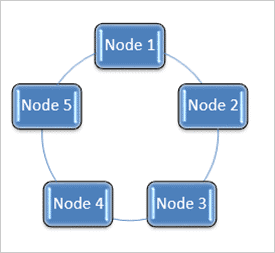
Each device will have two neighbors. The data flow in this topology is unidirectional but can be made bidirectional by using the dual connection between each node which is called a dual ring topology.
In a dual ring topology, two rings work in the main and protection link so that if one link fails then the data will flow through the other link and keep the network alive, thereby providing self-healing architecture.
Advantages:
- Easy to install and expand.
- Can be easily used for transmitting huge traffic data.
Disadvantages:
- Failure of one node will affect the whole network.
- Troubleshooting is difficult in a ring topology.
#3) STAR Topology:
In this type of topology, all the nodes are connected to a single network device through a cable.

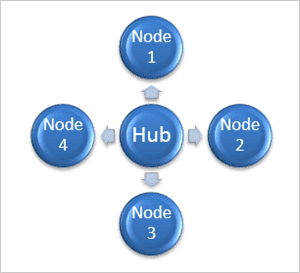
The network device can be a hub, switch or router, which will be a central node and all the other nodes will be connected with this central node. Every node has its own dedicated connectivity with the central node. The central node can behave as a repeater and can be used with OFC, twisted wire cable etc.
Advantages:
- Up-gradation of a Central node can be done easily.
- If one node fails, then it will not affect the whole network and the network will run smoothly.
- Troubleshooting of fault is easy.
- Simple to operate.
Disadvantages:
- High cost.
- If the central node gets faulty then the whole network will get interrupted as all nodes are dependent on the central one.
- Performance of the network is based on the performance and capacity of the central node.
#4) MESH Topology:
Every node is connected to another one with a point to point topology and every node is connected to each other.

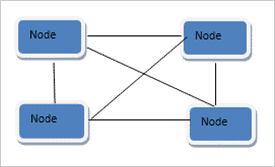
There are two techniques to transmit data over the Mesh Topology. One is routing and the other is flooding. In the routing technique, the nodes follow a routing logic as per the network required to direct the data from the source to destination using the shortest path.
In the flooding technique, the same data is transmitted to all the nodes of the network, hence no routing logic is required. The network is robust in case of flooding and it is hard to lose any data, however, it leads to unwanted load over the network.
Advantages:
- It is robust.
- Fault can easily be detected.
- Very secure
Disadvantages:
- Very costly.
- Installation and configuration are hard.
#5) TREE Topology:
It has a root node and all the sub-nodes are connected to the root node in the form of the tree, thereby making a hierarchy. Normally, it has three levels of hierarchy and it can be expanded according to the need of the network.
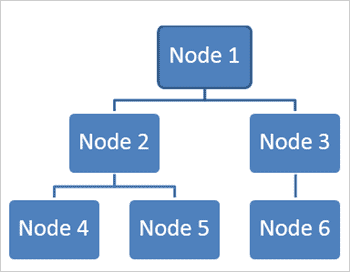
Advantages:
- Fault detection is easy.
- Can expand the network whenever needed as per the requirement.
- Easy maintenance.
Disadvantages:
- High cost.
- When used for WAN, it is difficult to maintain.
Transmission Modes in Computer Networks
It is the method of transmitting the data between two nodes connected over a network.
There are three types of Transmission modes, which are explained below:
#1) Simplex Mode:
In this type of mode, data can be sent in one direction only. Hence the communication mode is unidirectional. Here, we can just send data and we can’t expect to receive any response to it.
Example: Speakers, CPU, monitor, television broadcasting, etc.
#2) Half-Duplex Mode:
Half-duplex mode means data can be transmitted in both the directions on a single carrier frequency, but not at the same time.
Example: Walkie-talkie – In this, the message can be sent in both the directions but only one at a time.
#3) Full-Duplex Mode:
Full duplex means that the data can be sent in both the directions simultaneously.
Example: Telephone – in which both the people using it can talk and listen at the same time.
Transmission Mediums in Computer Networks
Transmission media is the medium through which we will exchange data in the form of voice/message/video between the source and destination point.
The first layer of the OSI layer i.e. the physical layer plays an important role of providing the transmission media to send data from the sender to receiver or exchange data from one point to another. We will further study this in detail about it.
Depending upon the factors like the type of network, cost & ease of installation, environmental conditions, the need of the business and the distances between sender & receiver, we will decide which transmission medium will be suitable for an exchange of data.
Types of Transmission Media:

#1) Coaxial Cable:

Coaxial cable is basically two conductors which are parallel to each other. Copper is mainly used in the coaxial cable as a central conductor and it can be in the form of solid line wire. It is surrounded by a PVC installation in which a shield is having an outer metallic wrapping.
The outer part is used as a shield against the noise and also as a conductor which completes the whole circuit. The outermost part is a plastic cover which is used to protect the overall cable.
It was used in the analog communication systems where a single cable network can carry 10K voice signals. Cable TV network providers also widely use the Coaxial cable in the entire TV network.
#2) Twisted Pair Cable:

It is the most popular wired transmission medium and is used very widely. It is cheap and is easier to install than coaxial cables.
It consists of two conductors (commonly copper is used), each having their own plastic insulation and twisted with each other. One is grounded and the other is used to carry signals from the sender to the receiver. Separate pairs are used for sending and receiving.
There are two types of twisted pair cables, i.e. Unshielded twisted pair and Shielded twisted pair cable. In the telecommunication systems, RJ 45 connector cable which is a combination of 4 pairs of cables are widely used.
It is used in LAN communication and telephone landline connections as it has a high-bandwidth capacity and provides high data and voice rate connections.
#3) Fiber Optic Cable:
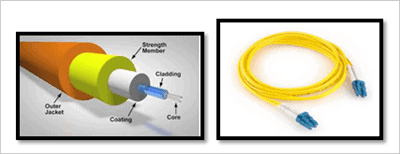
A fiber optic cable is made up of a core surrounded by a transparent cladding material with a lesser index of reflection. It uses the properties of light for signals to travel between them. Thus Light is kept in the core by using the method of total internal reflection which causes the fiber to act as a waveguide.
In multi-mode fiber, there are multiple propagation paths and the fibers used to have wider core diameters. This type of fiber is mostly used in intra-building solutions.
Whereas in single mode fibers there is a single propagation path and the core diameter used is comparatively smaller. This type of fiber is used in Wide area networks.
An optic fiber is a flexible and transparent fiber which consists of silica glass or plastic. Optic fibers transmit signals in the form of light between the two ends of the fiber hence they permit transmission over longer distances and at a higher bandwidth than the coaxial and twisted pair cables or electrical cables.
Fibers are used instead of metal wires in this, therefore, the signal will travel with very less loss of signals from the sender to receiver and also immune to electromagnetic interference. Thus its efficiency and reliability are very high and also it is very light in weight.
Due to the above properties of Fiber optic cables, these are mostly preferable over electric wires for long distance communications. The only disadvantage of OFC is its high-installation cost and its maintenance is also very difficult.
Wireless Communication Media
So far we have studied the wired communication modes in which we have used conductors or guided media for communication to carry signals from the source to destination and we have used glass or copper wire as a physical media for the communication purposes.
The media which transports the electromagnetic signals without using any physical medium is called a wireless communication media or unguided transmission media. The signals are broadcast through the air and are available to anyone who is having the capability to receive it.
The frequency used for wireless communication is from 3KHz to 900THz.
We can categorize wireless communication into 3 ways as mentioned below:
#1) Radio waves:
The signals which have transmitting frequency ranging from 3KHz to 1 GHz are called radio waves.
These are omnidirectional as when an antenna transmits the signals, it will send it in all the directions, which means that sending & receiving antenna’s need not be aligned with each other. If one sends the radio wave signals, then any antenna having the receiving properties can receive it.
Its disadvantage is that, as the signals are transmitted through radio waves, it can be intercepted by anyone, hence it is not suitable for sending classified important data, but can be used for the purpose where there are only one sender and many receivers.
Example: It is used in AM, FM radio, television & paging.
#2) Microwaves:
The signals which have transmitting frequency ranging from 1GHz to 300GHz are called microwaves.
These are unidirectional waves, which means that when the signal is transmitted between the sender and receiver antenna then both need to be aligned. Microwaves have fewer interference issues than the Radio wave communication as both the sender and receiver antenna are aligned at each other at both the ends.
Microwave propagation is the line-of-sight mode of communication and the towers with mounted antennas need to be in the direct line of sight, therefore, the tower height needs to be very high for proper communication. Two types of antennas are used for microwave communication i.e Parabolic dish and Horn.
Microwaves are useful in one to one communication systems due to its unidirectional properties. Thus, it is very widely used in satellite and wireless LAN communication.
It can also be used for long-distance telecommunication as microwaves can carry 1000’s of voice data at the same interval of time.
There are two types of microwave communication:
- Terrestrial microwave
- Satellite microwave
The only disadvantage of the microwave is that it is very costly.
#3) Infrared waves:
The signals which have transmitting frequency ranging from 300GHz to 400THz are called Infrared waves.
It can be used for short distance communication as infrared with high frequencies can’t penetrate the rooms and thus prevents the interference between one device to another.
Example: Use of infrared remote control by the neighbors.
Conclusion
Through this tutorial, we have studied the basic building blocks of computer networking and its significance in today’s digital world.
The different types of media, topology, and transmission modes used for connecting the various types of nodes in the network have also been explained here. We have also seen how computer networks are used for intra-building networking, inter-city networking, and world wide web i.e. internet.
NEXT Tutorial















![Toni Kroos là ai? [ sự thật về tiểu sử đầy đủ Toni Kroos ]](https://evbn.org/wp-content/uploads/New-Project-6635-1671934592.jpg)


